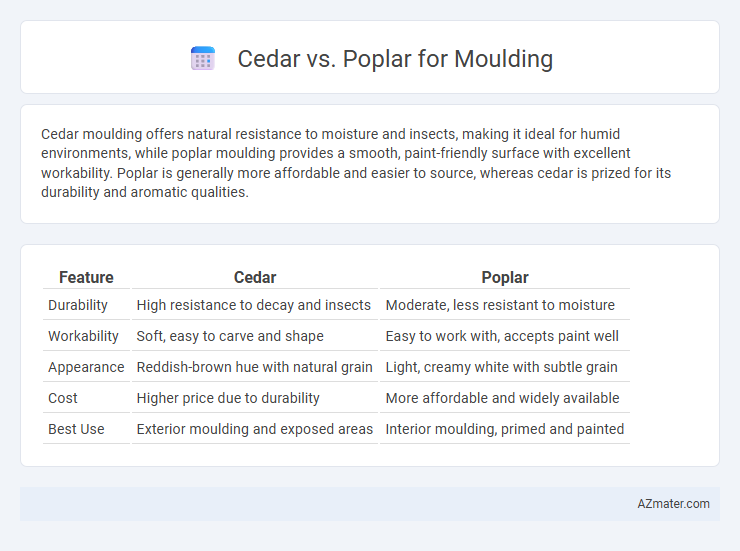Cedar moulding offers natural resistance to moisture and insects, making it ideal for humid environments, while poplar moulding provides a smooth, paint-friendly surface with excellent workability. Poplar is generally more affordable and easier to source, whereas cedar is prized for its durability and aromatic qualities.
Table of Comparison
| Feature | Cedar | Poplar |
|---|---|---|
| Durability | High resistance to decay and insects | Moderate, less resistant to moisture |
| Workability | Soft, easy to carve and shape | Easy to work with, accepts paint well |
| Appearance | Reddish-brown hue with natural grain | Light, creamy white with subtle grain |
| Cost | Higher price due to durability | More affordable and widely available |
| Best Use | Exterior moulding and exposed areas | Interior moulding, primed and painted |
Cedar vs Poplar for Moulding: An Overview
Cedar offers natural resistance to moisture and decay, making it ideal for moulding in high-humidity areas, while poplar is a more affordable, stable hardwood that takes paint exceptionally well. Cedar's aromatic properties also deter insects and provide a distinct grain pattern, whereas poplar's uniform texture allows for smooth finishes. When choosing between cedar and poplar for moulding, consider cedar's durability and organic appeal versus poplar's versatility and cost-effectiveness.
Wood Characteristics: Cedar and Poplar Compared
Cedar features natural oils that make it highly resistant to moisture, decay, and insect damage, ideal for moulding in damp areas. Poplar is a lightweight hardwood with a smooth, fine grain that accepts paint well but lacks the natural durability of cedar. While cedar offers superior longevity and aromatic properties, poplar is more cost-effective and easier to work with for detailed moulding projects.
Durability: Which Wood Lasts Longer?
Cedar offers superior durability for moulding due to its natural resistance to rot, decay, and insect damage, making it ideal for both indoor and outdoor applications. Poplar, while easier to work with and more affordable, tends to be less durable and prone to dents and scratches over time. For long-lasting moulding, cedar's density and natural oils contribute to a longer lifespan compared to poplar.
Workability: Ease of Cutting and Shaping
Cedar offers excellent workability for moulding due to its lightweight and fine grain, allowing smooth cutting and precise shaping with minimal tool wear. Poplar, being softer and straighter-grained, is highly adaptable and easy to machine, ideal for detailed profiles and intricate designs. Both woods respond well to hand and power tools, but poplar's consistent texture provides superior ease during sanding and finishing processes.
Appearance: Color, Grain, and Texture
Cedar moulding features a rich reddish-brown hue with distinct aromatic properties, showcasing a straight grain and a fine, even texture that enhances its natural beauty. In contrast, poplar moulding typically displays a pale cream to light greenish tone with subtle streaks, characterized by a relatively smooth texture and a straight to slightly wavy grain. The color depth and aromatic qualities of cedar provide a more luxurious and warm appearance, while poplar offers a versatile, neutral palette suited for painting or staining.
Cost Differences: Cedar vs Poplar Pricing
Poplar moulding typically costs between $1.50 and $3.00 per linear foot, making it an affordable option for budget-conscious projects. Cedar moulding, priced around $3.50 to $6.00 per linear foot, comes at a premium due to its natural resistance to decay and insect damage. Choosing poplar reduces initial expenses but cedar's durability can offer long-term savings.
Finishing and Painting Suitability
Cedar offers a smooth surface with natural oils that help resist moisture, making it excellent for finishing but requiring proper priming before painting to ensure adhesion. Poplar has a fine, uniform grain that accepts paint exceptionally well, making it a preferred choice for painted moldings due to its smooth finish and minimal bleeding. Both woods can be finished successfully, but Poplar is generally superior for paint applications, while Cedar excels with clear or stain finishes that highlight its natural beauty.
Resistance to Moisture and Insects
Cedar exhibits superior resistance to moisture and insects compared to poplar, making it an ideal choice for moulding in humid or pest-prone environments. The natural oils in cedar act as a protective barrier, reducing the likelihood of warping, rotting, and insect damage. Poplar, while easier to work with and more cost-effective, lacks these inherent properties and may require additional treatments to enhance durability against moisture and pests.
Environmental Sustainability and Sourcing
Cedar moulding is favored for environmental sustainability due to its natural resistance to decay and insects, reducing the need for chemical treatments. Poplar, often sourced from fast-growing plantations, supports sustainable forestry practices by enabling quicker replenishment and minimizing deforestation impacts. Both woods benefit from certifications like FSC, ensuring responsible harvesting and promoting eco-friendly building materials.
Best Applications: Choosing the Right Wood for Your Project
Cedar is ideal for moulding in moisture-prone areas like bathrooms and kitchens due to its natural resistance to rot and insects, making it perfect for exterior or high-humidity applications. Poplar offers a smooth, tight grain and takes paint exceptionally well, making it the best choice for interior moulding where a finished, painted look is desired. Selecting cedar enhances durability and natural beauty in outdoor or rustic projects, while poplar provides cost-effective versatility and ease of finishing for decorative indoor trim.

Infographic: Cedar vs Poplar for Moulding
 azmater.com
azmater.com